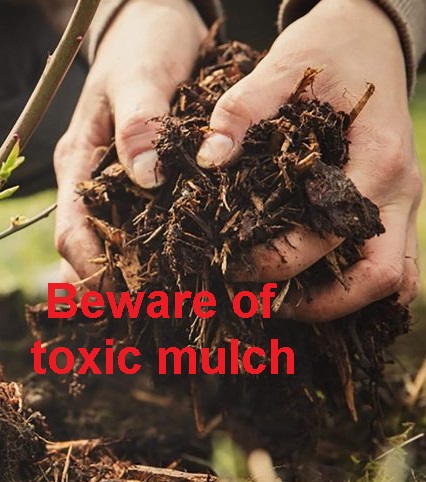Have you ever spread fresh mulch in your garden only to find later that some of your plants have turned brown or died? This article explains why some mulch is toxic and how to recognize it before purchasing it.
Beware of toxic mulch
Have you ever spread fresh mulch in your garden only to find later that some of your plants have turned brown or died? This article explains why some mulch is toxic and how to recognize it before purchasing it.
Cover beds are becoming very popular these days, and mulching can be really good for the plants and soil in your garden, but there are things that need to be monitored.
Here in Ohio, the most common type of mulch people use is chopped hardwood sawdust, which is a by-product of the woodworking industry. When they run the tree trunks to the sawmill, the first thing they do is peel it off. Years ago, bark was a big problem to mills because there was no useful purpose for it, until people realized the hidden benefits it had. To this day, bark is a nuisance to publishing plants, and they don't always understand how to handle it properly.
They like to stack it as high as possible in order to take up less space in their backyard. Mulch really tends to back up during the winter months due to less demand. In order for the mills to pile up on the high mulch, they literally have to drive the large front loaders into the pile. Naturally, the weight of these large machines compresses the sawdust in the pile, and this can become a big problem for you or me if we get some shavings that are piled too tightly, and squeezed very tightly.
When defoliation is first peeled, the mulch is fairly fresh, and needs to be decomposed before we dare to use it around our plants. The decomposition process requires oxygen and air to flow into the mound. When the mulch is very tightly compressed, this airflow cannot occur, and as decomposition continues the mulch becomes very hot as the organic matter ferments. Sometimes, the intense heat combined with the inability to release heat can cause the mound to explode in the flame through spontaneous combustion.
In other cases, the mulch is heated, cannot release gas, and the mulch actually becomes toxic. When this happens, a strong mulch odor develops that will take your breath away as you dig into the mound. When you spread this toxic mantle around your plants, the gas that contains it is released, and this gas can burn your plants.
It has happened to me twice. Once at my home, once at a job I was doing for a client. This poisonous mulch is very powerful. We poured a little mulch into the leaves of the Dwarf Alberta spruce we were covering, and after just a few minutes clean the mulch off the plant. The next day, my client noticed that one side of the plant was all brown. Mulch was there for only a few minutes.
Not only did I have to replace the Dwarf Alberta Spruce but the cap also damaged at least 10 other plants that I had to replace. I once saw a place where someone ordered a truck load of mulch, was it dumped in their driveway, and when the toxic cover slid from the dump truck onto the asphalt, the toxic gas released on the lawn next to the driveway settled.
The gas, not the mulch, turned the grass brown next to the brush pile.
The same person spread several yards of mulch around their home before realizing the problem, and destroyed many of their plants.
Now that's the tricky part. She tries to explain to you how to identify toxic mulch. It has a very strong scent that will take your breath away. But again, almost all mulch has a strong odor. This is very different from the typical smell of mulch, but I couldn't explain it better than that.
The mulch looks completely natural, and may be a little darker than usual. If you suspect a mulch problem, take a few shovels and place them around an inexpensive plant. Maybe just a couple of flowers. When performing this test, use mulch from inside the brush pile, not from the edges. Mulch at the edge of the pile has likely released most of the toxic gases it might have trapped.
If the test plants are fine after 24 hours, the mulch should be fine. The
The purpose of this article is not to cause panic in yard mulch, but toxic mulch can cause massive damage. In my house, they burned the leaves of some plants in my landscape, and they burned the grass next to the bed all the way around the house. It looked as if someone had picked up a lamp and burned the grass again about 2 inches all the way around the bed. If I hadn't seen him with my own eyes I would not have believed it.
Hypothalamus, hypothalamic fungus, hypothalamus, hypothalamic problems




0 Comments